Archive for June, 2009
(Non-consecutive) Consecutive Sudoku 12×12
Jun 30th
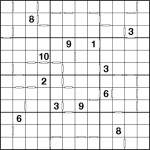
Consecutive 12×12 Sudoku puzzle
After a bit of a break to meet a major book deadline – the non-consecutive part of the title of this posting – I’m back with what seems to be one of the most popular types of puzzle, a Consecutive Sudoku. I wanted something a little bit different, though, so this is a Consecutive Sudoku 12×12. I personally always find Sudoku 12×12 pretty similar to regular 9×9 Sudoku to solve, unlike something like 16×16 which personally I’d never really bother with (apologies to anyone who loves them!).
In order to make the consecutive nature of the 12 possible values obvious, I’ve used one- and two-digit numbers rather than digits and letters. So the rules are simple: place 1 to 12 into each row, column and 4×3 box whilst obeying the white consecutive markers. Wherever there is a white consecutive marker between two squares then the difference of value in those two squares is 1; and conversely whereever there is no marker the difference is always greater than 1.
So sorry for the break – hopefully ‘normal’ service will now be resumed! ![]()
And good luck with the puzzle!
Skyscraper Sudoku 8×8
Jun 19th
Continuing my series of 8×8 Skyscrapers and variants, here’s an 8×8 Sudoku with Skyscraper clues around the edge.
The rules are simple:
- Place 1 to 8 in each row, column and 4×2 box
- Obey the Skyscraper constraints: each number outside the grid reveals the number of ‘visible’ digits looking along that row/column, where higher digits obscure lower ones
Good luck!
Consecutive Skyscraper 8×8
Jun 17th
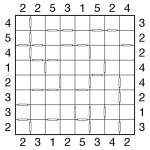
Consecutive Skyscraper 8×8 puzzle
Here’s a combination I haven’t posted before – a standard skyscraper puzzle with the addition of consecutive markers between adjacent squares. This allows the creation of an 8×8 puzzle without needing to also add Sudoku boxes.
The rules are as follows:
- Place 1-8 in each row and column
- Numbers outside the grid reveal the number of ‘visible’ numbers looking along that row/column, where higher numbers obscure lower ones
- White bars between squares reveal all consecutive squares – those where the difference is one
Good luck! ![]()
Skyscraper 8×8
Jun 13th
I thought it would be fun to post an 8×8 Skyscraper puzzle today – larger than any previous ‘vanilla’ Skyscraper puzzles I’ve posted. As I’ve mentioned before I don’t believe that it’s possible to create an 8×8 Skyscraper puzzle without any givens within the grid, so this one has a slash of 4s across the diagonal to help you along the way and ensure a unique solution.
The rules are pretty simple: place 1 to 8 in each row and column whilst obeying the Skyscraper constraints, which specify how many numbers are ‘visible’ from each edge position whereby higher numbers obscure all lower numbers on that row/column. See earlier postings for more detailed instructions.
Good luck! ![]()
Codeword
Jun 12th
I see this is only my second post in the past week, so sorry for the lower quantity of puzzles. I’m somewhat puzzled-out during the day creating lots of different types, so I’ve spent less time on making them for my blog where I don’t have a deadline to meet! ![]()
Today I’ve decided to post a Codeword, simply because I’ve never posted one before and I thought it would be fun to have one – it’s not a very original puzzle, but I probably need a few everyday puzzles in order to make the unusual ones stand out more! ![]() The aim of a Codeword puzzle is simply to work out which letter is represented by each value – all 26 letters must be placed at least once into the grid, and each number represents a different letter. The result should be a completed crossword grid, full of English words (and without proper nouns).
The aim of a Codeword puzzle is simply to work out which letter is represented by each value – all 26 letters must be placed at least once into the grid, and each number represents a different letter. The result should be a completed crossword grid, full of English words (and without proper nouns).
Good luck! ![]()
Word Square
Jun 10th
I’ve been working on all sorts of puzzles the past few days – from codewords to skyscraper sudoku to all sorts of word puzzles, including the attached: a word square. None of the ones I’ve made for the current book I’m working on are quite as large as this, however!
The aim is simple – by starting on any letter and moving from square to adjacent square in any direction, including diagonals, how many words can you form? For each word you cannot visit a square more than once on your path. For example, starting at the left you could make ‘TEND’ by running up the left column and then across, but you could not go on to also make ‘TENDED’ because that would be reusing at least the ‘D’.
There is an 18-letter word in there for you to find. If you find 100 words you’ve done well; if you find 140 you’ve done extremely well; and if you get to 175 then frankly I’m amazed! Any reasonable English word is valid, so long as it can be written without a capital letter.
Good luck!
SSSS: Skyscraper Shuriken Samurai Sudoku
Jun 5th
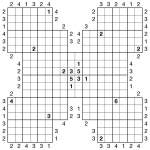
Skyscraper Shuriken Samurai Sudoku puzzle
I’m glad yesterday’s Shuriken Samurai went down well, so today I’ve upgraded it to a Skyscraper puzzle (following Christine’s request for more Skyscrapers!). This is, I think it’s fair to say, quite a bit harder than the basic Samurai yesterday was – but then any puzzle with a title this hard to say quickly really shouldn’t be able to be solved quickly either… ![]()
The rules are the same as yesterday (place 1-6 into each row, column and 2×3 box of the 13 underlying 6×6 Sudoku grids) but with the addition of Skyscraper constraints: place numbers so that the given number of digits can be ’seen’ from each external Skyscraper clue outside the grid. From the vantage point of each Skyscraper clue look along the adjacent row/column – with higher numbers obscuring all lower numbers (or those of the same value), the clue tells you how many numbers are visible. Check back to older puzzles I’ve posted for more detailed help.
Good luck! ![]()
Shuriken Samurai Sudoku
Jun 4th
Here’s a fun little puzzle. A say ‘little’ because it revolves around 6×6 grids and some easy logic, although it actually involves 13 of them so it’s not exactly small either. But I think it looks quite fun – the X shape and the X of givens makes it look a Japanese Shuriken weapon (or perhaps that’s just me), but anyway here it is.
Simply place 1-6 into each row, column and bold-lined 2×3 box of each of the 13 underlying 6×6 Sudoku grids.
Good luck! ![]()
Double Samurai Star
Jun 3rd
Following Spittledung’s comment on the Samura-i puzzle about it being nearly a double samurai star / flower samurai, I thought it would be fun to try out what exactly that would really look like – and so here is the result!
All of the 11 possible 9×9 grids are present, and you must place 1-9 into each row, column and 3×3 box of each of these underlying grids.
Good luck! ![]()
Samurai Square 9-grid
Jun 2nd
I was thinking about the tight overlay of grids in the (improved) Samura-I puzzles, and wondered what it would be like if you made a 15×15 puzzle simply by overlaying 9 Sudoku grids at all possible offsets. The answer is attached. This is definitely rated easy – there are lots of possible eliminations at all stages, and you shouldn’t need pencilmarks to solve it.
Of course, this principle can be extended to any arbitrary size of puzzle, but I imagine it would get a bit tedious if it was much larger…
So – can you place 1 to 9 into each row, column and 3×3 bold-lined box of each of the 9 underlying Sudoku grids in this puzzle? You’ll need to solve all 9 grids simultaneously to reach the solution.
Good luck! ![]()
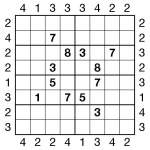
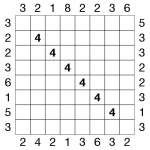
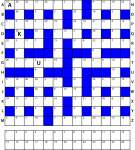

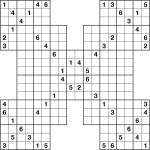

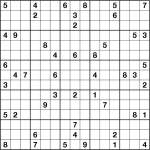

Recent Comments